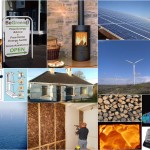How will we make sure that the lights don’t go out and that everyone in the Dunbar area can keep warm in 2025? Where will the electricity to run our appliances and communication systems come from? How will local businesses and farms meet their energy needs and how will we travel where we need to while using 50% less fossil fuel?
By 2025 our demand for energy will need to have greatly reduced. We will need to make much more efficient use of the energy that is available and we will need to be making much more use of renewable sources of heat and electricity. To ensure resilience, we will need a diversity of supply and a range of local energy sources that are under local control.
All new homes and workspace will be built to Passivhaus standards while a major programme of refurbishment will be underway to drastically cut energy consumption in our existing building stock. Renewable sources of heat will be in common use. In rural areas, biomass heating (using firewood, wood pellet or woodchip) will be common. Existing, often neglected, woodlands will be managed to ensure a local timber supply while maximising firewood production. New woodland will be established on marginal land and as shelterbelts on farms. There will increasingly be a return to traditional coppicing. A local supply chain will be in place to manufacture and supply pellets and woodchip locally and to make use of local waste wood and sawdust. Farms will supply their own energy needs and most will be net exporters of energy. Several villages will have installed district heating schemes.
Green gas from anaerobic digestors fed with food waste will supply the local gas grid. Electricity will mostly come from wind turbines. Many will be in community ownership and will also generate income for community investment, particularly in energy efficiency measures. Suitable south facing roofs will be used for photovoltaics and solar hot water. Small scale hydro power will be in use where possible, especially along the Tyne near East Linton. Dunbar and District will be a net exporter of electricity but, when necessary, will be able to draw energy from the grid which will be increasingly fed from tidal and wave power, as well as offshore windpower. Large offshore windfarms will have been constructed off the coast and their maintenance will be important for the local economy.
Where electricity is used for heating it will mostly be used to power heat pumps, transferring heat from the air, ground or water. Smart grids and appliances will help match electrical supply and demand while smart meters will ensure that householders can easily monitor and control their consumption. When surplus electricity is available, it will be used to charge electric vehicles and to heat water in thermal stores.

